Want faster, easier swimming that holds up on race day?
Focus on improving your swimming technique. It helps, how you hold your body, breathe, catch water, kick, turn, and start. Clean lines reduce drag, a better catch increases propulsion, and precise timing ties it all together.
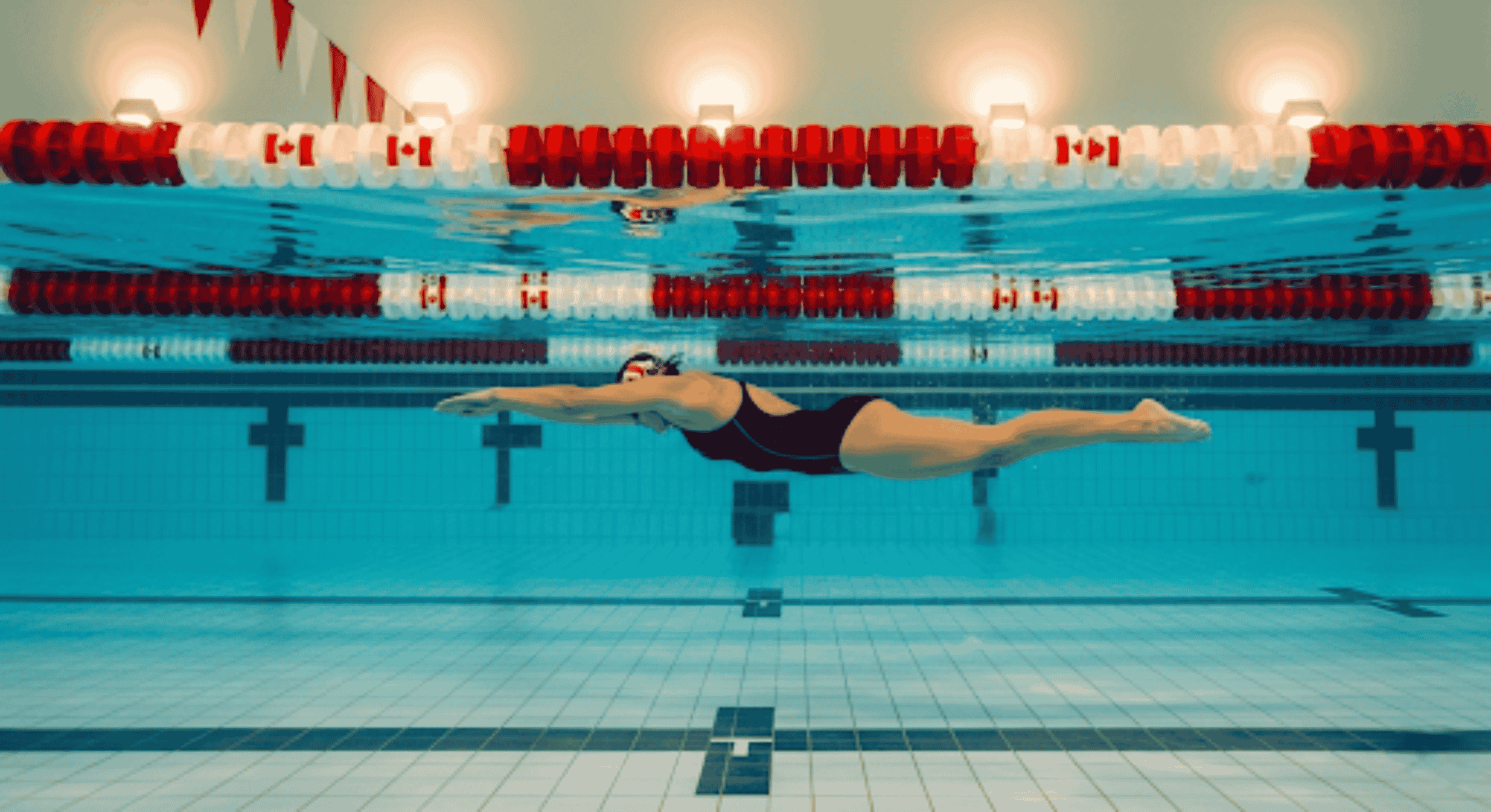
Stay with us, In this guide, We’ve covered freestyle, backstroke, breaststroke, and butterfly, with drills, cues, and simple checkpoints everything you need to improve your swimming technique to be a better swimmer.
Examples draw on GTA (Greater Toronto Area’s) pools and programs influenced by Swimming Canada so you can train smart, track progress, and swim with confidence.
Let’s dive in…..
What is Swimming Technique?
Swimming technique is the set of skills that move you forward with the least drag and the most control. In short, it is how you shape your body in the water, how you breathe, and how your arms and legs connect to create steady speed. Good technique lets you swim farther with fewer strokes, hold race pace, and feel in control.
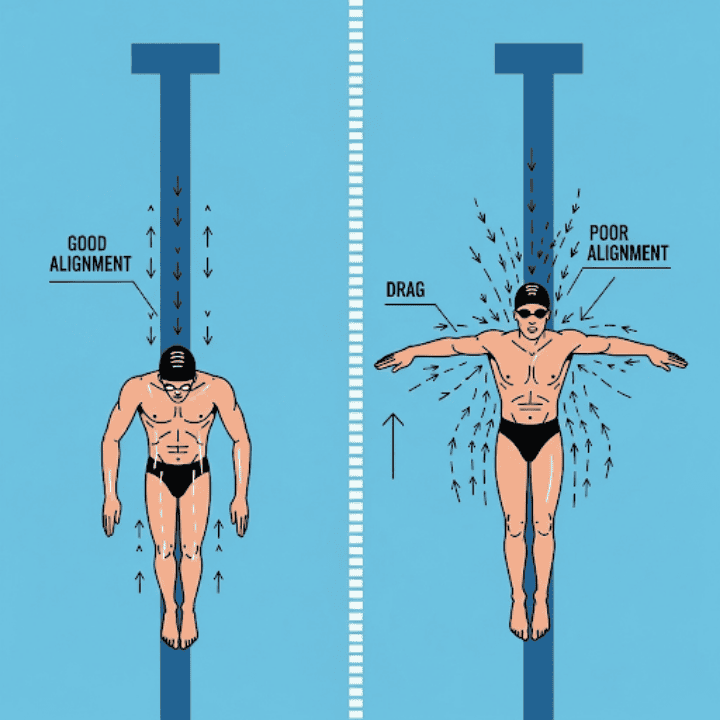
Think of your body as a long, balanced line. A level head sets hip height, which lowers drag. Your hands “catch” still water, then your forearms and palms press it back. Your kick adds rhythm and holds the line. Breathing is part of the stroke, not a pause. These parts must fit together.
That is why coaches in ROCKET SWIM pair drills with short sets, video, and simple metrics like stroke count and split times to confirm progress.
Why mastering swimming techniques is important for most Swimmers
Better Swimming technique is the fastest path to easier speed. It cuts drag, turns your strength into forward motion, and helps you hold pace when it matters in practice and competition.
Technique work also makes your training effective. Short skill blocks, video clips, and simple numbers like stroke count and split times tell you if a real change is happening. This lets competitive and adult swimmers in Canada progress even on busy schedules.
Four Core Swimming Strokes and How to Improve Them
These are the four strokes you race most.
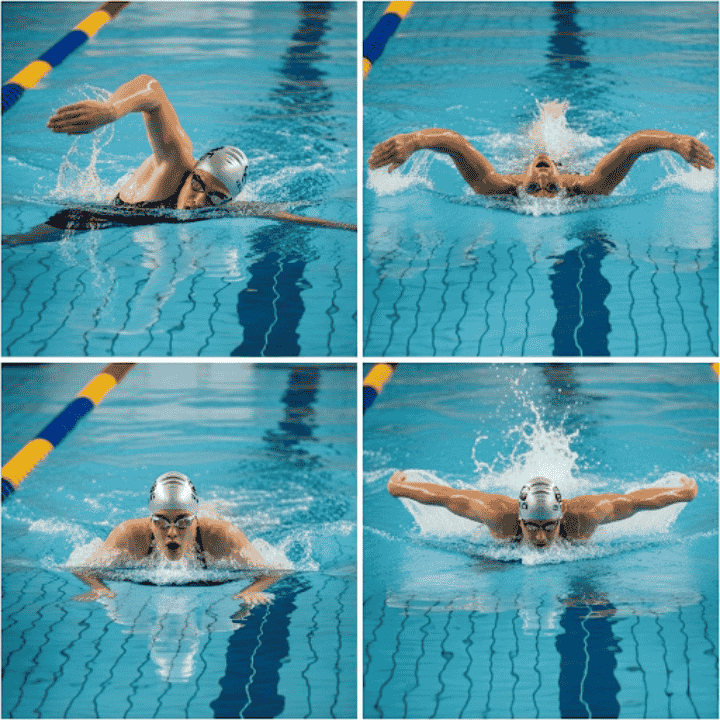
Well, In the above picture you ‘re seeing, how the specific strokes look like. let’s breakdown more:
Swimming Techniques for Freestyle
Freestyle is the fastest surface stroke. You swim face down, the arms alternate, and the legs use a flutter kick.

How to make it better: keep your eyes down, stretch long, and roll the body as the hand enters. Start the catch with fingertips slightly down, keep the elbow high, and press water straight back. Breathe with the roll, one goggle in the water, then return the head before the pull finishes.
-
Common fixes: shorten the crossover, quiet the kick, exhale in the water.
-
Try these drills: catch-up for timing, scull in front for feel, snorkel work for head-down balance.
Swimming Techniques For Breaststroke
Breaststroke runs on timing. The arms sweep out-in-forward while the legs use a whip kick. Face stays in for the glide, then lifts to breathe as the pull happens.
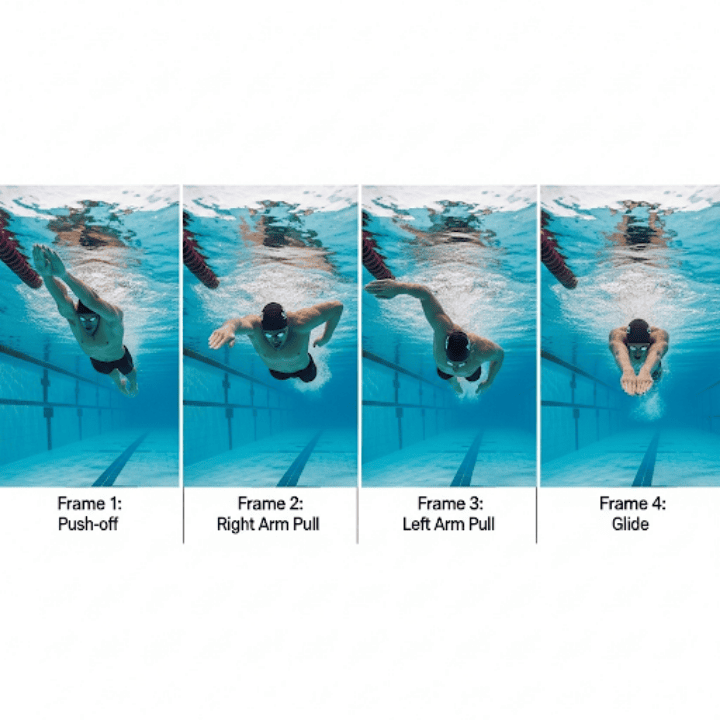
How to make it better: think pull, breath, kick, glide. Keep the elbows high on the in-sweep, send the hands forward close to the surface, and finish the kick with the legs long behind you. Keep the knees narrow so the thighs do not block water.
-
Common fixes: narrow the pull, bring heels to hips without lifting the knees forward, hold a calm glide.
-
Try these drills: kick on the back for ankle turn-out, two-count glide cycles, pull-buoy breast pull for clean lines.
Swimming Techniques For Backstroke
Backstroke is face up with an alternating arm action and a flutter kick. Rotation drives the stroke.
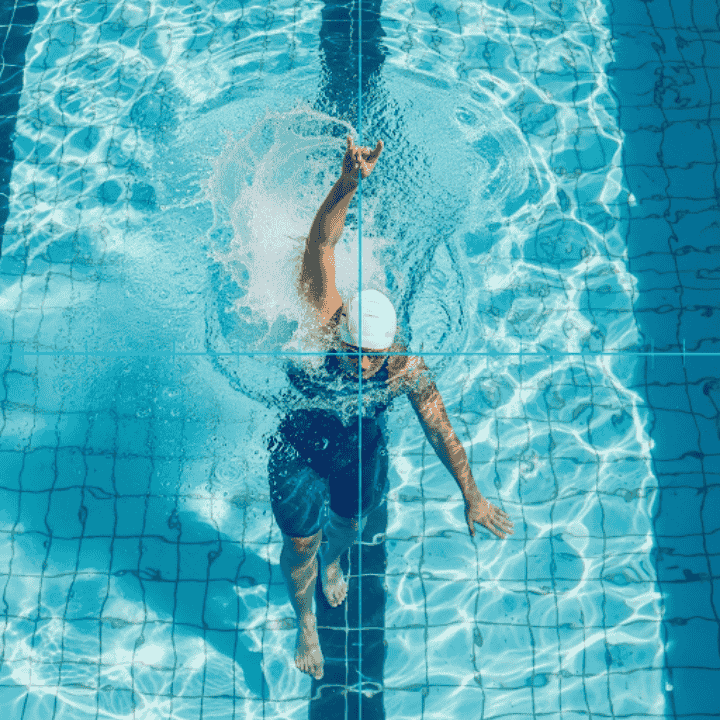
How to make it better: keep the chin neutral and the hips high. Enter pinky first above the shoulder, set the catch just under the surface with a bent elbow, and press water toward the feet. Kick from the hips with loose ankles to steady the line.
-
Common fixes: widen the entry to shoulder line, reduce up-and-down head movement, light but steady kick.
-
Try these drills: 6-3-6 rotation drill, single-arm with the other arm at the side, stroke-count to the flags for consistent turns.
Swimming Techniques For Butterfly
Butterfly uses both arms moving together with a dolphin kick. You breathe when the hands are under the shoulders, then place the head back down before the hands exit.
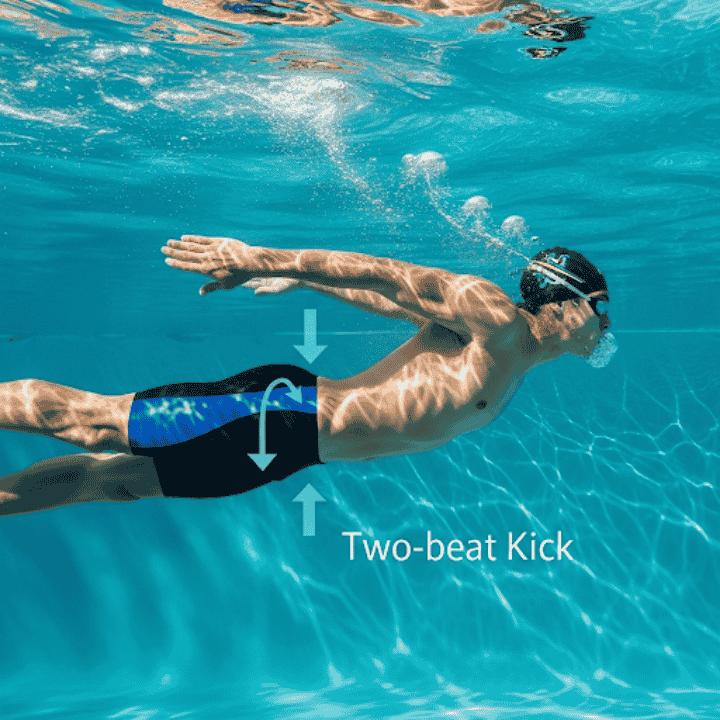
How to make it better: lead with the chest, let the hips rise, and pair two light kicks per arm cycle. Set a soft, high-elbow catch and keep the pull close under the body. Think small, smooth waves, not big heaves.
-
Common fixes: lower the breath, keep the kick narrow, shorten the pull to keep rhythm.
-
Try these drills: one-arm fly with fins, 3-3-3 drill, dolphin kick on the back for core rhythm.
Swimming Body Position and Balance Techniques
A balanced body line is your biggest speed tool. When you lie long and level, the water lets you through with less drag. Think head quiet, hips near the surface, and a steady kick that holds you straight. These skills carry into every set you do at Rocketswim Club in Toronto
Alignment checkpoints

Do these quick checks at the wall, off the push, and mid-length.
-
Head quiet, one long line from crown to heels
-
Hands reach forward on shoulder tracks, no crossover
-
Ribs down, tummy firm, lower back flat
-
Hips near the surface, heels just brushing bubbles
-
Kick from the hips, ankles loose, toes pointed
Balance and hip height
Hips ride high when the front end is calm and the lungs are under you.
In freestyle, look down, press the chest slightly, and let the kick hold the back end up.
In backstroke, lift the tummy and keep the chin neutral so the hips do not sink. If you feel heavy legs, breathe out more and shorten the kick amplitude so the thighs stay in line.
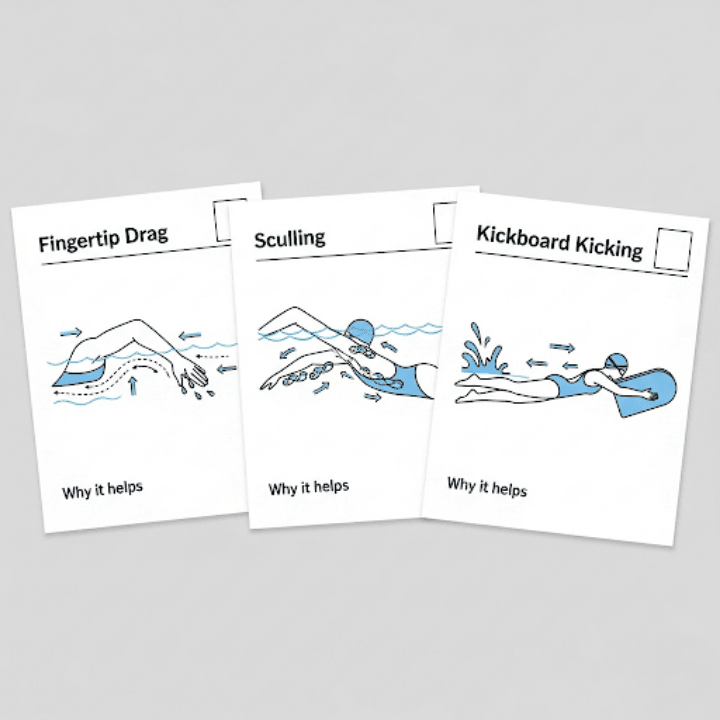
You can also try these simple feel drills:
-
Superman glide, six kicks, then one stroke to keep hips up
-
Side-kick with snorkel, bottom shoulder to chin, top hip dry
-
6-3-6 drill, count six kicks on the side, take three strokes, switch sides
Breathing Techniques for Swimming
Breathing should fit the stroke without breaking your line. Exhale in the water, then take a quick, low breath as you roll, ideally with “One goggle in, one out” This keeps hips high and timing clean.
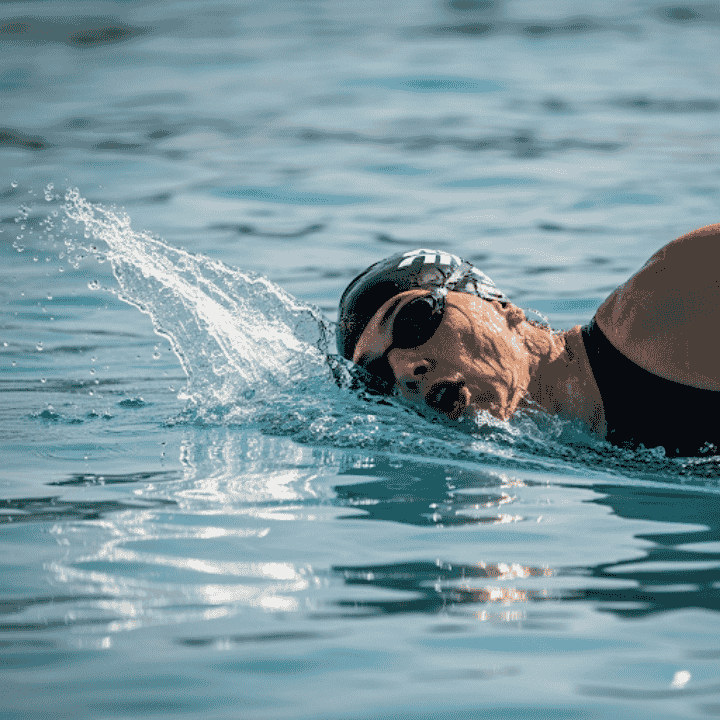 .”
.”
Always try to start simple. Practice relaxed exhale at the wall, then add easy full-stroke breathing, and later build patterns that suit your pace and event. Bilateral work helps symmetry, though many racers still prefer a dominant-side breath when swimming fast
Timing and patterns
Breathe as the body rolls, not by lifting the head and finish the exhale in the water, sip air as the mouth clears, then place the head back before the arm exits. Use easy sets that assign a pattern, for example every 3 strokes for balance or every 2 strokes for race rhythm.
Adults, confidence first
If breathing feels rushed, step back. Do wall breathing, then kick with a snorkel to learn head-still rotation, then swim short repeats keeping one goggle in the water on the breath. Build bilateral comfort gradually in warm-ups before using it at pace.
Catch and Pull Exercises
In this exercise, we suggest you get faster when your hand and forearm hold the water early, then press it straight back. This section builds that skill with simple drills and smart tools so your catch and pull feel strong in any swimming pool. Early vertical forearm, often called a “high-elbow catch,” is a core cue in freestyle and backs up the same idea in the other strokes.
The catch, feel
Start by learning to “feel” pressure on the palm and forearm. Use front scull at extension, moving the hands in small in-out sweeps while keeping elbows higher than wrists. The goal is to find steady resistance, not to muscle the water. This is the quickest path to a better catch for all strokes.
Add fist drill to shift the work from the hand to the forearm. Swim easy with closed fists for 25 to 50 metres, then open the hands and notice the extra “grip.” Rotate through short repeats so form stays clean.
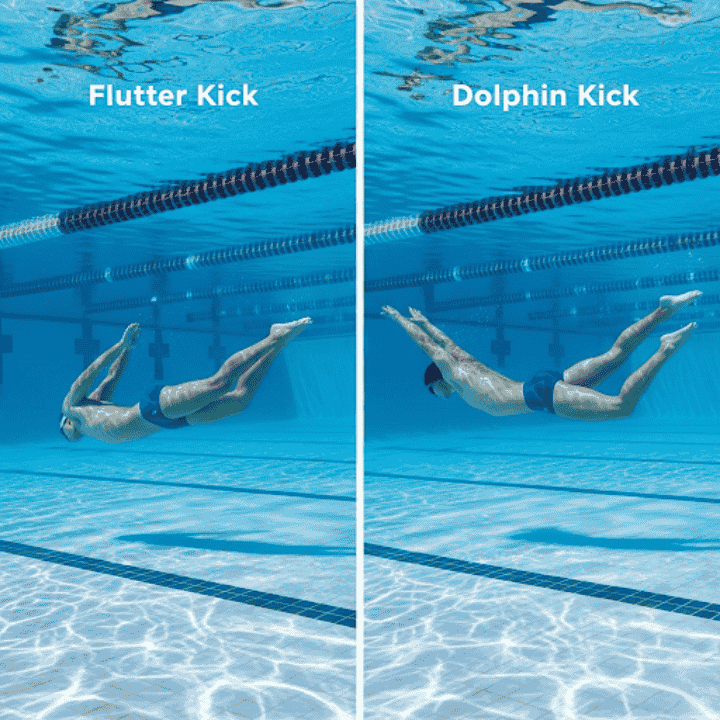
You can also use a snorkel for short sets so your head stays still while you build the catch. Pair it with light scull or easy freestyle so you can focus on shape first, speed later.
But if you add paddles, go small and keep reps modest. Paddles add load, which can help strength and give instant feedback on a dropped elbow, They also raise shoulder stress. In this case, you need to choose technique-oriented models and limit volume so quality stays high.
Pull paths by stroke
For Freestyle. Set a high elbow soon after entry so the forearm points down and back. Press water straight toward your feet, not down, and finish by the hip. This is the classic early vertical forearm pattern.
For Backstroke. Roll the body and bend the elbow under the surface so the forearm pulls back without spilling water. Enter pinky first above the shoulder line, then catch and pull with a firm, bent elbow
For Breaststroke. Keep the out-sweep compact, then in-sweep with high elbows toward the chest before sending the hands forward into streamline. Match the pull to the kick so you do not rush past the glide.
For Butterfly. Set a soft, high-elbow catch under the shoulders and keep the pull close. Tie the first kick to the hand entry and the second kick to the hand exit so rhythm stays smooth.
Efficient Kick Techniques in Swimming by Stroke
A good kick holds your line, links timing, and adds speed without wasting energy. Make it small, steady, and from the hips. Use tools and short sets to build a reliable rhythm you can carry in any swimming lane.
In freestyle and backstroke the flutter kick stabilises the body.
In butterfly the dolphin kick drives the wave.
In breaststroke the whip kick powers most of the stroke
Flutter kick
In flutter kick, you need to keep the eyes down, tummy firm, and kick from the hips with loose ankles. Make the kicks small and quick near the surface to keep the hips high and the body steady. This is the main job of the kick in front crawl and back crawl.
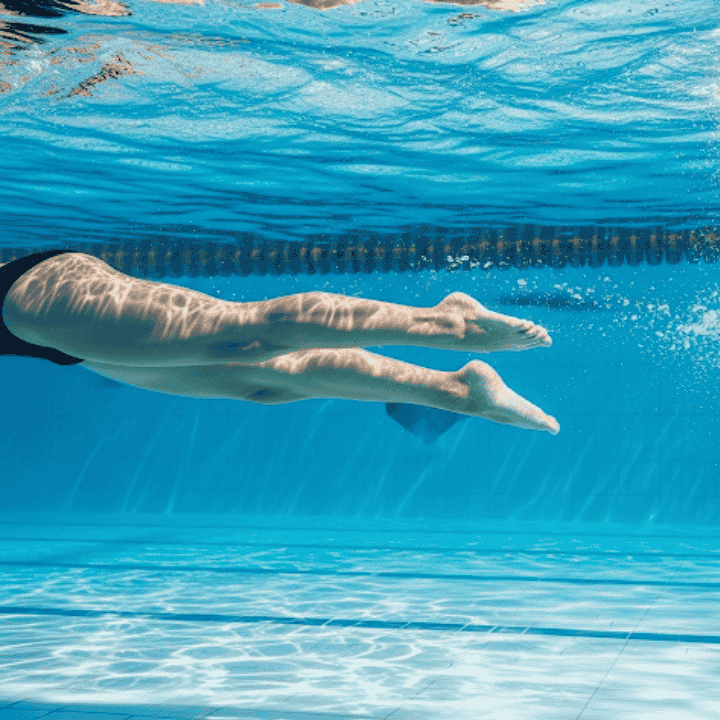
But if the kick feels heavy, try short vertical kicking sets to teach hip-driven motion, then repeat easy 25s with a centre-mount snorkel so the head stays still. You can add short fin work to feel a smoother rhythm, then remove the fins and keep the same beat.
Dolphin & Breast kick
Dolphin. Lead from the chest, let the hips follow, and use two clean beats per arm cycle when you swim butterfly. Underwater, your speed comes from a mix of kick size and kick rate, so find a comfortable amplitude and then build a crisp upbeat. Vertical dolphin and fin sets help you lock the rhythm before you add speed.
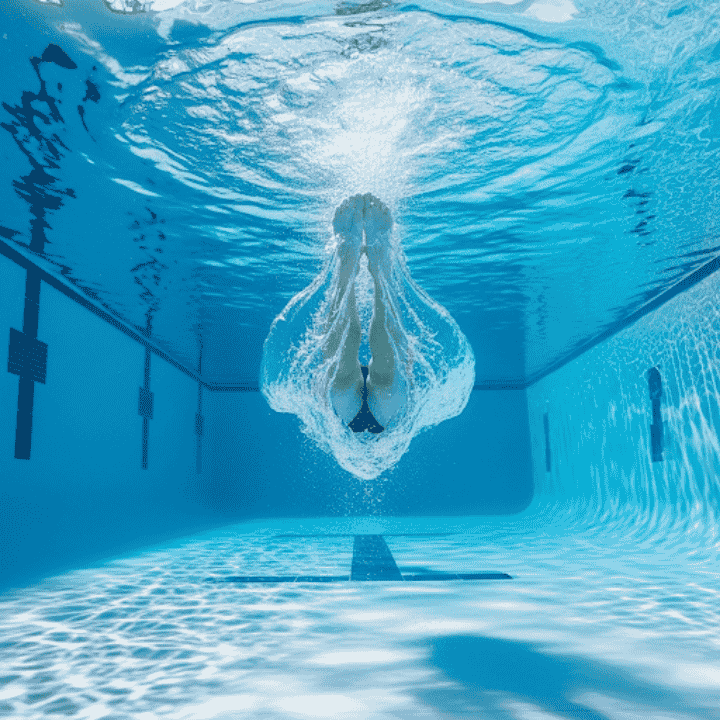
Breast. Pull, breathe, kick, glide. Turn the feet out, bring the heels toward the hips without lifting the knees forward, then sweep back and finish long. Rules require the feet to turn out during the propulsive part, and a single dolphin kick is allowed only after the start and each turn before the first breast kick. Keep the knees narrow so the thighs do not block water.
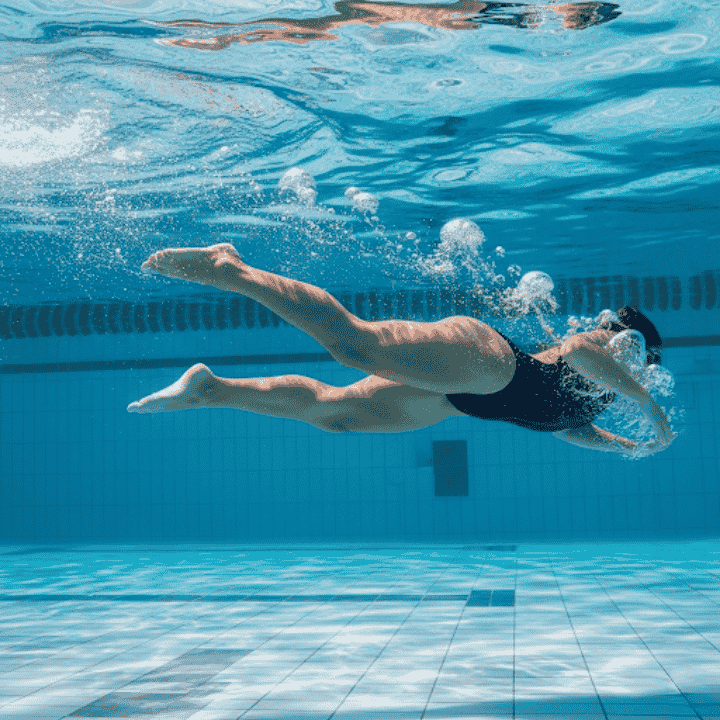
Simple groove work: kick on your back for ankle turn-out, then short breaststroke cycles where you count a calm glide before the next pull. These help adults and competitors find timing without fighting the water.
Techniques to Improve Starts and Streamline in Swimming
The two biggest freebies in a race are the start and the streamline. A firm block setup gives you speed into the water, and a tight streamline keeps that speed while you travel underwater up to the legal 15 m. World Aquatics allows full submersion only to 15 m after the start and turns, so your goal is a clean launch, a small entry hole, and a fast, low-drag line underwater.
Block setup and launch
Use a simple track start on blocks that have a back plate. Front foot at the front edge, back foot on the wedge, hips high, eyes down. On the signal, push hard through both legs, swing the arms forward, and leave the block in a flat line, not a dive that is too steep. The track start and grab start are both legal, but the track start with a back plate lets many swimmers create more forward force and control foot pressure.
Streamline and depth control
As soon as you enter, lock a tall streamline. Squeeze the arms to the ears, hands stacked, legs together, tummy firm. This reduces frontal area and keeps speed from bleeding away.
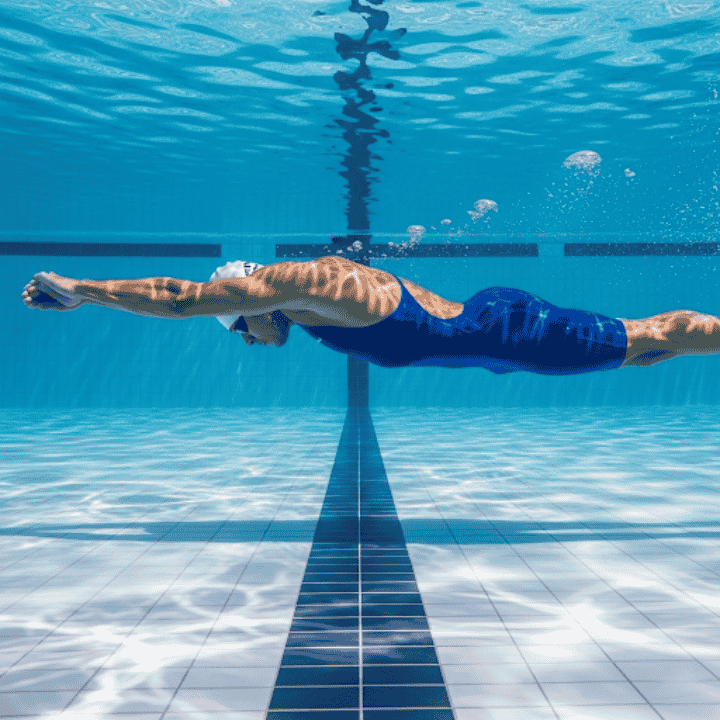
Aim to travel just below the surface, roughly 0.4 to 0.6 m deep, where studies show drag is lower than at the surface. Hold the line for a brief glide, then add crisp underwater dolphin kicks. Depth and kick size work together. Too shallow and you hit surface chop, too deep and you waste time climbing back up.
Keep the kicks fast and even, then rise to the surface before 15 m. Plan the breakout so the first stroke meets your speed without a pause. Train this with short sets that count distance to breakout and time to 15 m, since the underwater phase can decide a big chunk of a 50.
Techniques to Improve Turns and Transitions in Swimming
Your fast turns feel simple. You arrive under control, switch direction without stopping, then push off in a tight streamline and rise before 15 m.
Here, We’ll use a clean flip turn for freestyle and backstroke, and an open turn for breaststroke and butterfly. The order below keeps you smooth and legal in meets across the GTA
Flip and open turn order
Flip turn, step by step
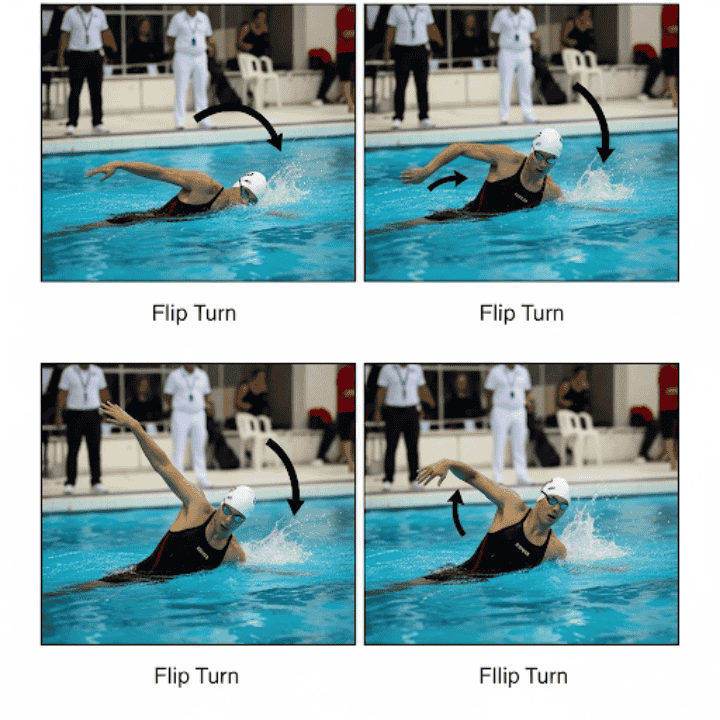
-
Pick your spot. Use the flags to judge distance, keep your last stroke long, and start the tuck as your head nears the T on the floor.
-
Tuck fast. Chin in, knees to chest, feet whip over to the wall.
-
Plant, then push. Place the feet hip-width, toes up, and drive off in a tight streamline.
-
Kick and rise. Add crisp dolphin or flutter, then break out before 15 m.
These steps are standard in coaching guides and are reinforced by skill studies that show gains in approach, somersault, push-off and glide after focused turn training
Open turn, step by step
-
Touch with two hands together.
-
Tuck the knees and rotate your body as one hand sweeps back under, the other “reaches to call your mother.”
-
Snap into streamline on your side, then push and turn to the breast. Keep it compact so you leave fast and legal every time.
Stroke-specific rules
In Freestyle. Touch the wall every length. You may be fully submerged at the turn, but your head must break the surface by 15 m after push-off. Flip turns are standard.
In Backstroke. You must swim on your back, except during the turn. You can rotate onto the breast to start the turn with one immediate, continuous pull into the wall, then you must push off on your back. Head must surface by 15 m.
In Breaststroke. You must touch with both hands simultaneously at the wall. After the push-off you may take one arm pull with one permitted butterfly kick at any time before the first breast kick, then resume breaststroke timing.
In Butterfly. You must touch with both hands simultaneously at the wall. Push off on the breast, use a legal fly kick pattern, and surface by 15 m.
Techniques to Improve Pacing, Stroke Rate, and Distance per Stroke
You can swim faster when stroke rate and distance per stroke work together. Rate is how often you take a stroke. Distance per stroke is how far you travel each stroke.
Your goal is to find a repeatable mix you can hold across the set and the race. You can watch video or research on elite swimmers shows speed comes from managing both, not just spinning faster.
Choose tempo
Pick a tempo you can hold with clean form. Use a tempo trainer to beep every stroke or every 25 m. Set beeps per minute to target stroke rate, or set a 25 m split and hit the wall on the beep. Start conservative, then adjust by tiny steps until the stroke feels smooth and repeatable. Studies show simple audio cues help swimmers lock pace more accurately.
Track efficiency
Count strokes for one or two lengths, then time the repeat. That gives you a clear view of distance per stroke and pace together. SWOLF, which adds time and strokes for a length, is another simple check. Use it hard as well as easy, since only counting during glidey, easy lengths can mislead you.
If needed add a Critical Swim Speed test a few times per season. Do a 400 and a 200 time trial in one session, then use the result to set aerobic training paces. CSS comes from peer-reviewed work on critical velocity and is widely used by coaches for steady pace work.
Drill Finder, fault by fault
Keep this simple map in your mesh bag. Pick one fault, choose one drill, and re-test pace and stroke count after a few short repeats.
- Crossover on entry → alignment focus and crossover fixes from USMS.
- Slipping catch → front scull and hand-pitch sculls to build feel.
- Breath breaks rhythm → single-arm freestyle with snorkel to sync timing.
Alignment faults
If the hands cross the midline, the body snakes and you lose distance per stroke. Enter on shoulder tracks and keep the reach straight. USMS outlines clear fixes for crossover in freestyle and backstroke, including line checks and simple visual cues. Re-test with a short pace set to confirm the change sticks.
How to Improve Propulsion & timing faults by Proper Swimming Technique
Hold the water sooner and time the breath so the pull stays strong. Sculling drills teach hand pitch and pressure, which improves the early catch in all strokes. One-arm freestyle tightens timing and shows you if the breath is late or the elbow is dropping. Build changes with short repeats so form never falls apart.
Swimming Techniques for Adults and Family Swimmers
Adults and families progress fastest when breathing feels calm and the body line stays simple. We start with relaxed exhale work, then add short, clear drills that grow into full strokes you can use in any City of Toronto pool. Adult swimming programs in Toronto are set up for step-by-step skill building, so this approach fits right in.
Relaxed breath first
Start with breathing that doesn’t break your line. Stand or hold the wall, face in, and exhale slowly into the water, then turn to sip air and place the face back down before you pull. This rhythm keeps hips high and stops the urge to lift the head. USMS and Swimming Canada coaching materials both stress steady exhale and a low, quick breath.
For families and newer swimmers, blend in basic safety habits as you practice, like calm entries, front and side floats, and shallow-water glides. These skills build comfort while you learn stroke timing.
From drills to full stroke
Use short sets that link a drill directly to swimming, so the skill survives when you add speed.
- Side-kick to swim: Kick on your side with one arm extended, head still, slow exhale. Take 3 strokes and switch sides, then swim easy 25 m with the same quiet head. This teaches body balance and a low breath.
- Front glide to stroke: Push off in a tight streamline, glide, then add one good stroke and breathe low. Repeat as 25s until the first strokes feel smooth, then connect to continuous freestyle.
- Snorkel catch work: 4 × 25 m with snorkel focusing on early catch and steady kick, then 1 × 50 m without snorkel keeping the same feel. Builds catch shape without breath tension.
Book time with Rocket swim’s Adult Swim class to practice these progressions at your pace. RSWIM’s programs offer adult streams where you can work on these exact skills in a structured setting.
Swim Metrics, What to Track (How do you know your swimming techniques are improving)
You improve what you measure. Track a few clean numbers in every set, then look for steady trends. For technique, the simplest checks are stroke count, time, and how far you travel per stroke. Add one pacing tool and one aerobic marker and you have a full picture.
Efficiency measures
Count strokes for a length, then note the time. Lower strokes at the same time, or the same strokes at a faster time, usually means better efficiency. United States Masters Swimming coaches use this simple count to help swimmers find a personal “sweet spot” for distance per stroke.
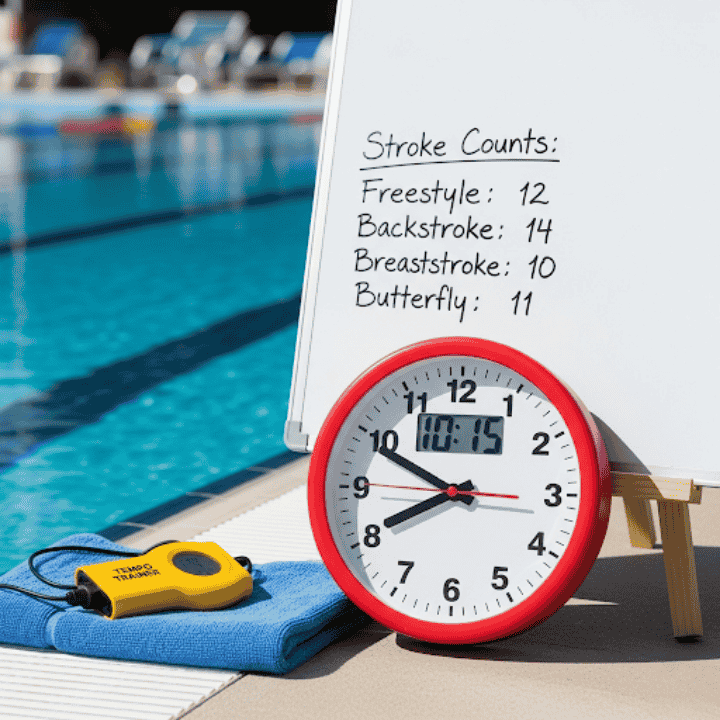
SWOLF blends those two numbers. It is time for a length plus stroke count for that length. A lower score suggests you are travelling farther per stroke or holding speed with fewer strokes. Use it as a trend, not a trophy. Different pools and pacing styles will shift the raw number.
Speed and pacing
Use a tempo trainer to lock rhythm. You can set beeps per minute to guide stroke rate or set a beep every 25 m to hold splits. It is a simple way to hit even pacing and to feel the effect of tiny rate changes on your stroke quality.
Add a Critical Swim Speed check each training block. Do one 400 and one 200 time trial on the same day, then use the result as your aerobic training pace. CSS gives a steady yardstick across weeks, and coaches use it widely for distance and middle distance work.
Tools and Equipment for Improving Swimming Technique
Use tools to solve a clear problem, then remove the tool and keep the skill. A snorkel helps you keep the head still. Fins build kick rhythm and balance.
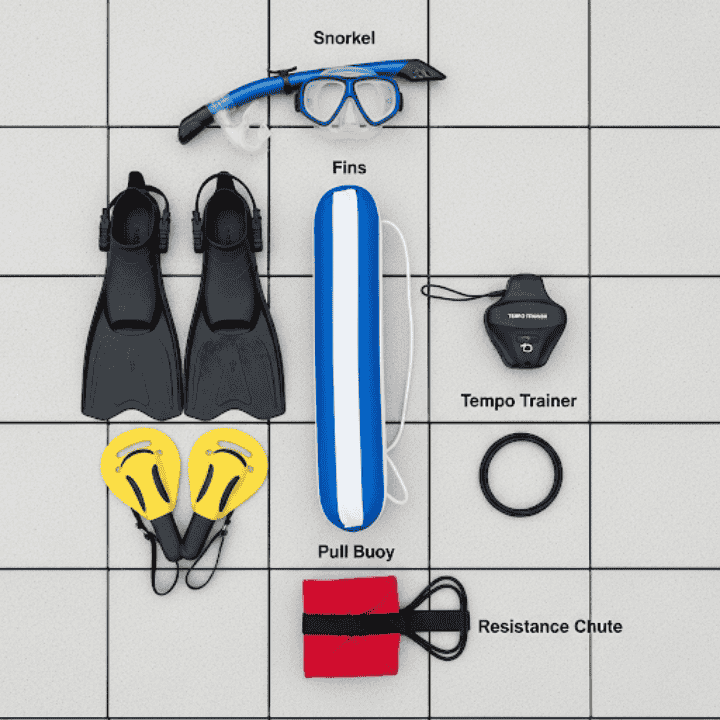
Paddles highlight the catch. A pull buoy lets you feel body position. A tempo trainer controls stroke rate or splits. Parachutes and drag socks add water resistance.
Match tool to outcome
-
Snorkel for line and timing. A centre-mount snorkel lets you focus on body line, catch shape, and steady exhale without turning the head. It is widely used for skill work and aerobic sets.
- Fins for rhythm. Short or medium fins help you feel hip-led kicking, improve up-kick, and hold a higher training speed while keeping form.
- Paddles for catch feedback. Start small so you feel hand angle and a high elbow without stressing the shoulder. Increase size only if form stays clean.
- Pull buoy for body position. Place it between the thighs to lift the legs and notice how a level body reduces drag. Use it as a check, not a crutch.
- Tempo trainer for pacing. Beep by stroke or by 25 m to lock rate or splits. Metronome methods are common in coaching and can standardise stroke rate during practice.
- Parachute or drag socks for power. Added drag raises propulsive demand. Recent work quantifies load by chute size and speed so sets are easier to plan.
Safe use and sizing
Pick the smallest tool that achieves the goal, then progress slowly.
- Paddles. Choose a smaller size first. Extra pressure can strain the shoulder if technique is off. Stop if you feel joint pain.
- Fins. Fit and comfort matter. Short-blade styles are versatile for technique work, and poor fit can cause blisters or change your kick pattern.
- Kick support. Many coaches limit long kickboard sets because head-up posture can arch the back. Alternatives include streamline kick or snorkel-kick to keep alignment. If you use a board, keep the face down and arms long.
How Dryland Helps Improve Swimming Techniques
Dryland raises the ceiling for what your in-water technique can deliver. Meta-analyses show resistance training improves upper-body strength and short-distance front crawl performance, with likely gains coming from how strength supports stroke rate and force.
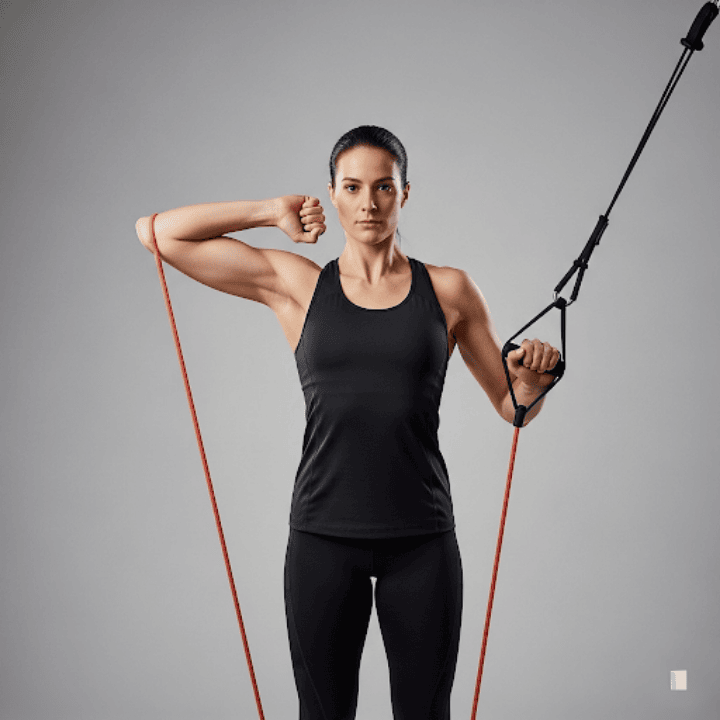
Plyometric and strength work can also improve turn performance. Some studies show mixed transfer to free-swim times, so pair land work with focused technique sets.
Mobility that matters
Target mobility that supports clean shapes in the water.
-
Ankles for dolphin and breast. Greater ankle strength and flexibility relate to faster underwater dolphin kick. Breaststroke speed is linked to technique and leg rotation control, which argues for careful hip and knee mobility plus foot turn-out control.
- Shoulders and scapula. Keep the cuff and scapular muscles healthy to tolerate catch work. National and research resources flag high training volumes and poor control as risks, and they promote prehab and smart load progressions.
Simple plan for most swimmers in the GTA: ankle mobility and foot point work, thoracic rotation and extension, gentle external-rotation band work, and scapular control. Build changes slowly and keep pain away from 4 out of 10.
Strength that transfers
Choose land moves that look like the forces you need in the pool.
-
Upper body pulling for catch and pull strength.
-
Lower body power for push-off and underwater kicking.
-
Plyometrics and core for faster turns and stable lines off the wall.
Systematic reviews report that resistance training improves sprint performance, and focused strength, ballistic, and plyometric work can improve turns. Keep volume modest and pair each block with in-pool technique so strength shows up in your stroke.
Techniques to Improve Mindset and Skill in Swimming
Mental skills make your stroke hold up when it counts. A short pre-performance routine, clear self-talk, and simple imagery reduce nerves and keep attention on the next cue, not the clock. Canadian programs, including Swimming Canada and CSIO in Toronto, provide mental performance support that mirrors this approach.
Focus and confidence
Build a 20 to 30 second routine you use before efforts and races. Keep it simple.
-
Breathe for a few slow cycles to settle arousal.
-
Image one clean breakout or turn, as if from your own eyes.
-
Cue word that fits the stroke, like “high elbow,” “soft hands,” or “hips up.”
-
Commit to the first length plan.
Meta-analyses show that pre-performance routines, self-talk, and imagery improve execution under pressure across sports. Swimmer-specific work suggests a taught routine can lift speed and efficiency compared with ad-hoc habits. Use short sets to practise the routine so it feels automatic.
If you prefer a checklist, ask your coach at CSIO or through a club supported by Swimming Canada’s IST to help you script and test it. Confidence grows when the same steps give the same feel in practice and in meets.
Transfer skills to meet
Train like you race, then race like you train. Tie your mental routine to physical checkpoints you already use.
-
Starts and breakouts. Run your routine, then time to 15 m. Note the number and keep it within a tight range. That same number is your meet target.
- Turns. Pair a cue word, for example “tight tuck,” with a set that measures wall-to-wall time. Bring the cue and the number to the meet warm-up.
- Pacing. Use a tempo trainer in practice to lock stroke rate or 25 m splits. At the meet, replay the rhythm in your head and use the same rate on lap one.
If meet nerves spike, swap to short, task-only self-talk like “eyes down, catch, press back,” then return to your plan on the next stroke. Evidence shows task-focused self-talk is effective for skill tasks.
Improve Your Swimming Technique With Rocketswim in the GTA
If you want hands-on help in Toronto, Rocket Swim Club offers clear, practical coaching you can use right away. Programs include private swimming sessions, adult pathways, Non-competitive swimming and competitive swimming squads, with current offerings published on the site.
Ready to fix your stroke in Toronto?
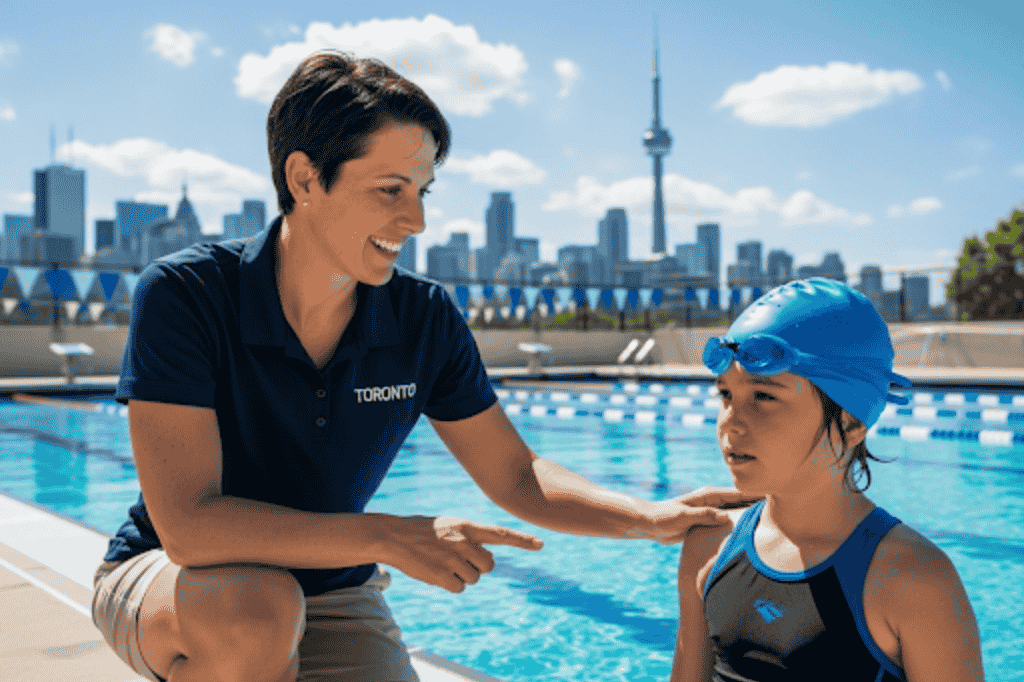
Book a technique session at Rocket Swim Club. We watch a short repeat, give one clear cue, and retest so the change sticks.
Freestyle, backstroke, breaststroke, or butterfly, adult or competitive, we coach to your goal and schedule. Choose a time that works and start swimming faster with less effort.

